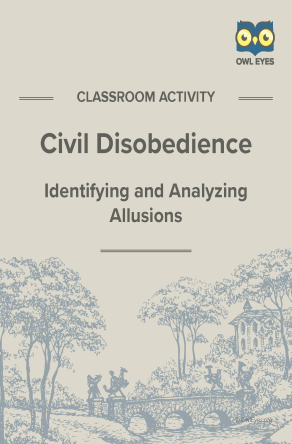Civil Disobedience Allusion Activity
- 8 pages
- Subject: Allusion, Literary Devices, Lesson Plans and Educational Resources
- Common Core Standards: RL.11-12.1, RL.11-12.4, RL.9-10.1, RL.9-10.4, RL.9-10.9
Additional Civil Disobedience Resources
Product Description
In 1859 Henry David Thoreau wrote “Civil Disobedience,” an essay in which he lays out his political philosophy and deep distrust of government. Thoreau had been motivated to write the piece after spending a night in jail for tax evasion, an event that surely fanned the flames of his noncompliance. As in his other writings, Thoreau makes frequent use of allusion, drawing on texts and events from throughout world history as he crafts his often idiosyncratic arguments. As the essay unfolds, Thoreau extends the Jeffersonian dictum that “that government is best which governs least” to “that government is best which governs not at all.”
Skills: analysis, close reading, drawing inferences from a text, interpreting implications of allusions
About This Document
The Owl Eyes Allusions activity gives students an opportunity to practice identifying and analyzing allusions. Allusions broaden the scope of a text and imbue passages of the text with deeper meaning by subtly drawing on literature, history, science, geography, philosophy, mythology, or other cultural sources. The main components of this activity include the following:
- A contextualized paragraph of the text
- A handout defining “allusion” with examples from classic works
- A list of tips for spotting allusions
- A step-by-step guide to activity procedure
- An example answer
In completing this activity, students will be able to identify, analyze, and interpret allusions, thereby accessing deeper meanings within the text.







